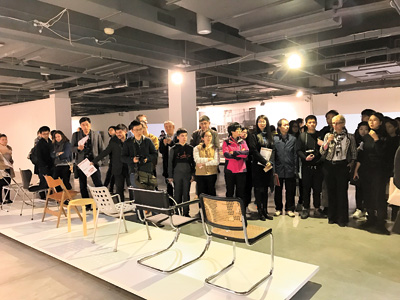
Anna Zhao anna.whizh@yahoo.com AN exhibition introducing elite German design from the 20th century is now open to local audiences at OCT Art & Design Gallery in Nanshan District through March 5. With furniture designs, posters, publications, architecture models, paintings as well as photographs and films arranged in chronological order in seven sections, the exhibition expounds on the 100-year history of Deutscher Werkbund, the German association for artists, architects, designers and industrialists. The designs and publications, especially those that led to extensive contemplation and debate on social issues, are reminiscent of the Werkbund’s leading role in the vicissitude of society in the 20th century. The Werkbund was born during an age when art and modern handicraft began to prosper in the late 19th century and the early 20th century, when society was seeking a return to workshop-production with better quality goods after a loss of craftsmanship and artistic quality as a result of mass production. Initiated by 12 artists and architects along with 12 corporations in Munich, the Werkbund was founded in October 1907 with the aim of “refining craft work in the interaction of art, industry and craft, by education, by propaganda and by adopting a unified approach to all relevant questions.” Its members included celebrated German designers, including Peter Behrens, Josef Hoffmannn and Richard Riemerschmid, Henry van de Velde and Hermann Muthesius, who had been throwing themselves on “reforming life” before the establishment of the Werkbund. The Werkbund agreed that the industrialized world should be transformed with art and good craftsmanship so that “well-formed objects” can send artistic messages to ordinary people and educate them and ultimately, establish “a good social custom.” It insisted that products should be designed in accordance to their usage, handling method, materials and manufacturing process to boost good value in use while allowing people to get a sense of beauty from them. In subsequent years, the movement led by the Werkbund proved to be a success — German product makers reaped not only good economic returns but also national brand recognition across the world. By presenting exemplary models at museums or promoting their standards for good art and craftsmanship on publications, the Werkbund soon assumed enormous importance and influence across Europe in the years before World War I, and similar associations were established in Austria, Switzerland, Sweden and Britain. In the 1920s the Werkbund played a leading role in major design experiments for the new world characterized by technology, international quality and mobility. Its monthly publications from 1922 to 1935 “Die Form (The Form),” which dealt with various issues in design, from furnishings to clothing, and from typography to housing construction, was the most popular cultural magazine in the Weimar Republic and it championed the Werkbund’s artistic aim and educational ideals. The 1929 exhibition “Film und Foto (Film and Photo)” in Stuttgart organized by the Werkbund was considered an important step in the implementation and dissemination of modern media art in the 20th century. Several large-scale exhibitions organized by the Werkbund promoted its ideal for a comprehensive design approach to all objects on the basis of new technical developments in the context of a radically changing world. The Weissenhof Housing Estate in Stuttgart, organized by the Werkbund in 1927, with buildings by architects including Le Corbusier, Mies van der Rohe, J.J.P. Oud and Hans Scharoun, is still considered as one of the most significant and internationally known examples of modern architecture in the 20th century. Following the housing experiment in Stuttgart, further Werkbund developments were realized in Brno (1928), Breslau (1929), Prague (1932), Neubühl (1932) and Vienna (1932) — they became models of housing and urban planning for “modern people.” The Werkbund’s work until the 1970s can be defined as transforming the industrialized world “from sofa cushion to urban development” from an artistic approach and as an effort to “educate” the populace with “well-formed” objects. Today, the widely recognized understanding in the world about “industrial design” — the course taught at universities, the objects developed by enterprises and products exhibited in museums — is primarily a merit of the Werkbund. Although its influence went into sharp decline during the Nazi regime, the Werkbund soon recomposed itself after World War II. Fifty years after its establishment, the Werkbund articulated a further topic of great social relevance: overdevelopment and environmental destruction as a result of unbridled industrialization and urbanization. At a conference on “The Great Destruction of the Land” in 1959, the problems of industrial society and the ecological impact driven by profit-oriented growth were openly addressed. In the last three decades of the 20th century, the Werkbund switched its interest from questions of production to problems of consumption, leading the discussion on how people should correctly handle products and the consequences of consumption. But not all Werkbund members were prepared to follow this path and an internal disintegration began. In 1986, the former Werkbund chairman Julius Posener raised the question: “Do we still need the Werkbund?” In the mid-1990s, internal difficulties led to the withdrawal of three federal state bodies from the umbrella organization. This process of fragmentation reduced the impact of Werkbund activities in the public realm. Deutscher Werkbund may be seen as the most important cultural institution in Germany alongside the Bauhaus in the 20th century. Much to its credit, it was the first to identify the ecological problems of industrial society and to make the public aware of environmental protection and the destruction of the landscape. The Shenzhen exhibition is the first stop of the Chinese tour. Time: Till March 5 Hours: 10 a.m.-5:30 p.m. (Closed on Mondays, open on holidays) Venue: OCT Art & Design Gallery, 9009-1 Shennan Boulevard, Overseas Chinese Town (南山区华侨城深南大道9009-1号) Metro: Luobao Line, OCT Station, Exit C (罗宝线华侨城站C出口) | 
